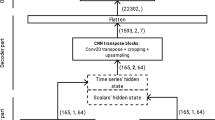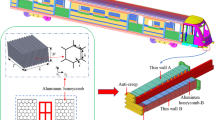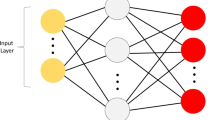Abstract
Evaluation and potential certification by analysis (CBA) has emerged as a promising tool to reduce costly crashworthiness tests of prototype, by using physics-based simulation and analysis. One of the major obstacles in the CBA implementation for vehicle crashworthiness certification is the discrepancy between computer-aided engineering (CAE) model prediction and the actual response of vehicle crash tests. This paper aims to improve the prediction accuracy of the crashworthiness CAE model under new test speed by fusing CAE data and a small number of crash test data using machine learning models. Two novel approaches are developed in the time domain and the displacement domain to achieve the goal of data fusion for the correction of the CAE model. More specifically, in the time domain (time vs. deceleration), a low-fidelity temporal convolutional network (TCN) is first trained using a large volume of simulation data generated from a CAE model. The low-fidelity TCN model is then fine-tuned to a multi-fidelity TCN through transfer learning using a small number of test data. In the displacement domain (displacement vs. deceleration), the deceleration response as a function of time is first converted into a function of displacement. A Gaussian process regression (GPR) model is then utilized to capture the model bias of the nonlinear spring constant under a dynamic analysis scheme. The learned GPR model finally is integrated into vehicle deceleration dynamic analysis along with the original CAE model to predict vehicle deceleration under a new crash speed. A real-world case study of vehicle crash tests is employed to validate the proposed two approaches. The results show that both proposed approaches in general can recover model bias of the CAE model and give a noticeable improvement in CAE model prediction accuracy.

















Similar content being viewed by others
References
Albawi S, Mohammed TA, Al-Zawi S (2017) Understanding of a convolutional neural network. In: 2017 International conference on engineering and technology (ICET), 2017. IEEE, pp 1–6
Arendt PD, Apley DW, Chen W (2012) Quantification of model uncertainty: Calibration, model discrepancy, and identifiability. J Mech Des 134(10):100908
Bai S, Kolter JZ, Koltun V (2018) An empirical evaluation of generic convolutional and recurrent networks for sequence modeling. In: International conference on learning representations (ICLR) workshop, 2018, vol 1803, p 01271
Barbat S, Fu Y, Zhan Z, Yang R-J, Gehre C (2013) Objective rating metric for dynamic systems. In: Enhanced safety of vehicles, Seoul, Republic of Korea, vol 2, no. 3, 2013
Caputo F, Lamanna G, Perfetto D, Chiariello A, Di Caprio F, Di Palma L (2021) Experimental and numerical crashworthiness study of a full-scale composite fuselage section. AIAA J 59(2):700–718
Chung J, Gulcehre C, Cho K, Bengio Y (2014) Empirical evaluation of gated recurrent neural networks on sequence modeling. arXiv preprint arXiv:1412.3555
Du X, Jiang B, Zhu F (2021) A new method for vehicle system safety design based on data mining with uncertainty modeling. Eng Struct 247:113184
Fang J, Sun G, Qiu N, Kim NH, Li Q (2017) On design optimization for structural crashworthiness and its state of the art. Struct Multidisc Optim 55(3):1091–1119
Farha YA, Gall J (2019) MS-TCN: multi-stage temporal convolutional network for action segmentation. In: Proceedings of the IEEE/CVF conference on computer vision and pattern recognition, 2019, pp 3575–3584
Gu X, Sun G, Li G, Mao L, Li Q (2013) A comparative study on multiobjective reliable and robust optimization for crashworthiness design of vehicle structure. Struct Multidisc Optim 48(3):669–684
Guida M, Manzoni A, Zuppardi A, Caputo F, Marulo F, De Luca A (2018) Development of a multibody system for crashworthiness certification of aircraft seat. Multibody Syst Dyn 44(2):191–221
Happian-Smith J (2001) An introduction to modern vehicle design. Elsevier, Oxford
Hochreiter S, Schmidhuber J (1997) Long short-term memory. Neural Comput 9(8):1735–1780
Huang X, Xie T, Wang Z, Chen L, Zhou Q, Hu Z (2022) A transfer learning-based multi-fidelity point-cloud neural network approach for melt pool modeling in additive manufacturing. ASCE–ASME J Risk Uncertain Eng Syst B 8(1):011104
International Organisation for Standardization (2014) Road vehicles—objective rating metric for non-ambiguous signals, ISO/TS 18571: 2014
Jackson KE, Fasanella EL, Lyle KH (2006) Crash certification by analysis—are we there yet? In: AHS International 62nd Annual Forum and technology display, 2006
Jiang C, Hu Z, Liu Y, Mourelatos ZP, Gorsich D, Jayakumar P (2020) A sequential calibration and validation framework for model uncertainty quantification and reduction. Comput Methods Appl Mech Eng 368:113172
Kennedy MC, O’Hagan A (2001) Bayesian calibration of computer models. J R Stat Soc B 63(3):425–464
Kleijnen JP (2009) Kriging metamodeling in simulation: a review. Eur J Oper Res 192(3):707–716
Kohar CP, Greve L, Eller TK, Connolly DS, Inal K (2021) A machine learning framework for accelerating the design process using CAE simulations: an application to finite element analysis in structural crashworthiness. Comput Methods Appl Mech Eng 385:114008
Lanzi L, Castelletti LML, Anghileri M (2004) Multi-objective optimisation of composite absorber shape under crashworthiness requirements. Compos Struct 65(3–4):433–441
Lea C, Vidal R, Reiter A, Hager GD (2016) Temporal convolutional networks: a unified approach to action segmentation. In: Computer vision—ECCV 2016 workshops, proceedings, Part III 14, 2016, Amsterdam, The Netherlands, 8–10 and 15–16 October 2016. Springer, pp 47–54.
Lea C, Flynn MD, Vidal R, Reiter A, Hager GD (2017) Temporal convolutional networks for action segmentation and detection. In: Proceedings of the IEEE conference on computer vision and pattern recognition, 2017, pp 156–165
Li L, Lin Q, Ming Z (2021) Multi-objective optimization using self-organizing decomposition and its application to crashworthiness design. Appl Soft Comput 101:107002
Olivares G, Acosta JF, Yadav V (2010) Certification by analysis I and II. In: The joint advanced materials and structures meeting, 2010
Pan SJ, Yang Q (2009) A survey on transfer learning. IEEE Trans Knowl Data Eng 22(10):1345–1359
Park J-S, Jeon J (2002) Estimation of input parameters in complex simulation using a Gaussian process metamodel. Probab Eng Mech 17(3):219–225
Quinonero-Candela J, Rasmussen CE (2005) A unifying view of sparse approximate Gaussian process regression. J Mach Learn Res 6:1939–1959
Rasmussen CE (2003) Gaussian processes in machine learning. In: Summer school on machine learning, 2003. Springer, pp 63–71
Rasmussen CE, Nickisch H (2010) Gaussian processes for machine learning (GPML) toolbox. J Mach Learn Res 11:3011–3015
Sarin H, Kokkolaras M, Hulbert G, Papalambros P, Barbat S, Yang R-J (2008) A comprehensive metric for comparing time histories in validation of simulation models with emphasis on vehicle safety applications. In: International design engineering technical conferences and computers and information in engineering conference, 2008, vol 43253, pp 1275–1286
Schulz E, Speekenbrink M, Krause A (2018) A tutorial on Gaussian process regression: modelling, exploring, and exploiting functions. J Math Psychol 85:1–16
Schwer LE (2007) An overview of the PTC 60/V&V 10: guide for verification and validation in computational solid mechanics. Eng Comput 23(4):245–252
Sinha K, Krishnan R, Raghavendra D (2007) Multi-objective robust optimisation for crashworthiness during side impact. Int J Veh Des 43(1–4):116–135
Sobester A, Forrester A, Keane A (2008) Engineering design via surrogate modelling: a practical guide. Wiley, Chichester
Sun G, Pang T, Fang J, Li G, Li Q (2017) Parameterization of criss-cross configurations for multiobjective crashworthiness optimization. Int J Mech Sci 124:145–157
Tang Z et al (2017) Data-driven train set crash dynamics simulation. Veh Syst Dyn 55(2):149–167
Thelen A et al (2022) A comprehensive review of digital twin—part 1: modeling and twinning enabling technologies. Struct Multidisc Optim 65(12):354
Thelen A et al (2023) A comprehensive review of digital twin—part 2: roles of uncertainty quantification and optimization, a battery digital twin, and perspectives. Struct Multidisc Optim 66(1):1
Wan R, Mei S, Wang J, Liu M, Yang F (2019) Multivariate temporal convolutional network: a deep neural networks approach for multivariate time series forecasting. Electronics 8(8):876
Wang X, Shi L (2014) A new metamodel method using Gaussian process based bias function for vehicle crashworthiness design. Int J Crashworthiness 19(3):311–321
Xi Z, Hao P, Fu Y, Yang R-J (2014) A copula-based approach for model bias characterization. SAE Int J Passeng Cars Mech Syst 7(2):781–786
Yin H, Wen G, Hou S, Chen K (2011) Crushing analysis and multiobjective crashworthiness optimization of honeycomb-filled single and bitubular polygonal tubes. Mater Des 32(8–9):4449–4460
Zeng J, Kim YH (2020) Identification of structural stiffness and mass using Bayesian model updating approach with known added mass: numerical investigation. Int J Struct Stab Dyn 20(11):2050123
Zeng J, Kim YH (2022) Probabilistic damage detection and identification of coupled structural parameters using Bayesian model updating with added mass. J Sound Vib 539:117275
Zeng J, Todd MD, Hu Z (2022) Probabilistic damage detection using a new likelihood-free Bayesian inference method. J Civ Struct Health Monit. https://doi.org/10.1007/s13349-022-00638-5
Zhan Z, Fu Y, Yang R-J (2013) On stochastic model interpolation and extrapolation methods for vehicle design. SAE Int J Mater Manuf 6(3):517–531
Zhan Z, Fu Y, Yang R-J (2014) A stochastic bias corrected response surface method and its application to reliability-based design optimization. SAE Int J Mater Manuf 7(2):262–268
Zhao Y, Jiang C, Vega MA, Todd MD, Hu Z (2022) Surrogate modeling of nonlinear dynamic systems: a comparative study. J Comput Inf Sci Eng 23(1):011001
Funding
Funding for this work was provided by Ford Motor Company through the University Research Program. The support is gratefully acknowledged. The first author would also like to thank Mr. Xufeng Huang and Dr. Chen Jiang for the help of TCN code.
Author information
Authors and Affiliations
Corresponding author
Ethics declarations
Conflict of interest
The authors have no relevant financial or nonfinancial conflicts of interest to disclose.
Replication of results
General information about vehicle specifications, test conditions, and pseudocode of the proposed method are provided in the manuscript. Detailed information related to vehicle specifications cannot be shared due to confidentiality. The other data and codes will be available upon request.
Additional information
Responsible Editor: Hongyi Xu
Publisher's Note
Springer Nature remains neutral with regard to jurisdictional claims in published maps and institutional affiliations.
Rights and permissions
Springer Nature or its licensor (e.g. a society or other partner) holds exclusive rights to this article under a publishing agreement with the author(s) or other rightsholder(s); author self-archiving of the accepted manuscript version of this article is solely governed by the terms of such publishing agreement and applicable law.
About this article
Cite this article
Zeng, J., Li, G., Gao, Z. et al. Machine learning enabled fusion of CAE data and test data for vehicle crashworthiness performance evaluation by analysis. Struct Multidisc Optim 66, 96 (2023). https://doi.org/10.1007/s00158-023-03553-5
Received:
Revised:
Accepted:
Published:
DOI: https://doi.org/10.1007/s00158-023-03553-5




